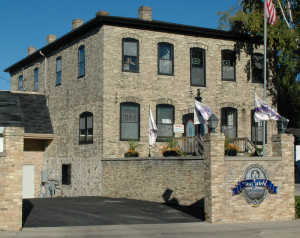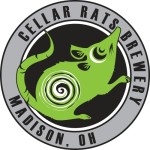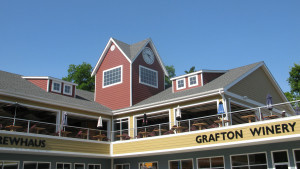Should Wineries Be Craft Brewers Too?
Diversifying product lines is a smart business move. But ask any of the increasing number of winery owners who have recently started to make beer and/or spirits as well as wine why they did it, and diversification is not usually their answer.

von Stiehl Winery in Algoma, Wisconsin is the state’s oldest licensed winery. Photo by Door County Wine Trail.
‘We like craft beer and we drink it,” says Brad Schmiling, a co-owner of Wisconsin’s von Stiehl Winery.
The winery, which produces 30 wines ranging from vinifera and French hybrids to fruit wines, started brewing beer last summer under the name Ahnapee Brewery. The name reflects an earlier brewery of the same name, with a brewmaster named Henry Schmiling — a distant relative of Brad Schmiling.
Today’s Ahnapee Brewery produces eight craft beers on tap. ‘Four are what we call our core beers, and four are seasonal. We try to balance between malty and hoppy beers,” says Schmiling.
Included in their current beer list is an American amber ale, a couple of India Pale Ales, a chocolate milk stout and a strong porter. The newest beer to be tapped is a Scottish Ale.
‘There is a business component to adding a brewery, of course,” says Schmiling, who notes Wisconsin may soon be adding beer trails to the state’s well-established wine trails. He hopes to draw some of that crowd. ‘But our family has had a 30-year passion for wine and beer,” he says.
At Chalet Debonne Vineyards in Madison, Ohio the reason for opening Cellar Rats Brewery is different. ‘Tony Debevc, Jr. came into the family business and his main interest was beer,” explains Joel Sandrey, sales and marketing director of both Cellar Rats and Debonne. Cellar Rats began brewing beer in 2008 and has grown the business exponentially. ‘We now do contract brewing for other people,” says Sandrey. ‘They give us their recipes, and supervise the process if they want, but we make the beer within our staff using our equipment.”
 As for the Cellar Rats label, the brewery produces six signature beers including various ales, wheat/American Hefeweizens, and stouts and porters. It also produces four seasonal ales and lagers.
As for the Cellar Rats label, the brewery produces six signature beers including various ales, wheat/American Hefeweizens, and stouts and porters. It also produces four seasonal ales and lagers.
Joe Schuchter, whose family owns Valley Vineyards in Warren County Ohio, says their winery started its Cellar Dweller craft brewery almost three years ago, but not because of the craft brew craze. ‘We obtained a full liquor license that would allow us to brew beer, and eventually distill spirits,” he says.
The family decided to start with a brewery because an uncle was an ardent home brewer and could translate that quickly to a craft brewery. ‘And we didn’t have to add to the winery’s footprint, we could work with our existing space,” Schuchter says.
Cellar Dweller started brewing six craft beers and now produces seven, ranging from pale ales to wheat beers, a stout, a light beer, an English ale and a black IPA.
At Grafton Winery & Brewhaus in Grafton, Illinois, owner Mike Nikonovich says the winery started in 2008 and the Brewhaus a year later. Of all the wineries with breweries, Nikonovich is one who reports the upward trend of craft beer made something of an impact. ‘Craft beer is going through a boom right now,” he says.
While Grafton was not looking to “hop” on the band wagon, ‘We did want to provide something for everyone to drink,” Nikonovich explains. Like many winery owners, he has visitors who ask if he has beer. As far as he knows, he has the only winery in the state right now that can answer that question with a ‘yes.”
Still, the production level is small. ‘Beer is only available in the Brewhaus and that’s open only on weekends,” says Nikonovich. In addition to Brewhaus beers, he also carries other craft beers. ‘People are looking for local and for something different,” he says. Even with a small production, however, Grafton Winery’s Brewhaus includes an award-winning IPA along with its wheat, stout, pilsner, and other varieties.
Most of the winery-brewery owners believe the winery-brewery or winery-distillery or the triple threat winery-brewery-distillery is likely to be the wave of the future for today’s wineries.
‘I think it depends on where your winery is located,” says Sandrey. In an area like Madison, Ohio where Debonne/Cellar Rates is located, there are plenty of wineries to visit. ‘Some may go to one winery for the restaurant, some for the beer, some for the wine, some for the view,” he says.
If you do decide to add a brewery to your winery, there are pros and cons. On the negative side, you will have to lay out some capital for the equipment; and unless you’re like Cellar Rats or Cellar Dwellers and have a family member or current employee who makes beer or has worked in a brewery, you’ll have to count in labor costs for a brewmaster as well.
But that’s only half of it. Because of the increase in micro-breweries, equipment isn’t always easy to come by. You may be on a waiting list for equipment and even for ingredients like hops and yeast.
That’s why Cellar Rats introduced contract brewing, says Sandrey. With contract brewing, would-be brewmasters can start up their micro-breweries while waiting for equipment. (It doesn’t hurt that it also allows Cellar Rats to derive some income from a competitor’s suceess.)
Once you have what you need however, there are definitely some pros on the other side of brewing. ‘It’s cheaper to make than wine,” says Schuchter. And there is more freedom in producing the product, adds Sandrey. ‘If you make a beer you don’t like, for example, you can pour it down the drain. You can’t do that with wine.”
Beer can also be turned around quickly which means once you start to make it, you can sell it faster than you can wine, which takes longer to produce. ‘Beer provides a quick pay-back,” says Nikonovich.
And after the winter most of the Midwest experienced, there’s another plus. Beer isn’t weather-dependent. You can make it year-round and not have to worry about what a polar vortex means for your crops — unless, of course, you’re growing your own hops.
Currently, Debonne Vineyards is growing its own hops, but only on an experimental basis ‘We have a test field that OSU (Ohio State University) has planted to see if hops can grow in the Midwest,” says Sandrey. ‘We’re not growing hops for production right now, but if OSU’s experiment is successful, it might be something we do in the future.”
A similar testing ground has been planted in southern Ohio at Valley Vineyards where 10-acres has been given over to hops. ‘We’re not using them to make our beer,” says Schuchter, but, like Debonne, if the experiment proves successful, ‘We have 50 to 60 acres that we can plant in hops,” he says.
‘There is a demand for hops right now,” says Schmiling. ‘So growing our own hops is something we might do in the future.” All of the winery-breweries report that, while many are expanding their beer selections, increasing the size of their breweries and adding equipment, wine is still their principle product line.
Even Debonne’s Cellar Rats line, with its contract brewing and growing distribution of its beer, says that wine remains the winery owner’s main product. That doesn’t mean, however, that, as a winery owner, you shouldn’t consider opening a brewery of your own — or a distillery. ‘A distillery might be a more logical choice for a winery,” says Schmiling. After all, he points out, the process of wine-making is similar to distilling, and you don’t need all the brewing equipment or specialized knowledge that you do with a brewery.

Round Barn Winery in Michigan may be the only winery in the U.S. that also has a brewery and a distillery.
There are already wineries, like Michigan’s Round BarnWinery, that produces grappa, an Italian grape brandy. (Round Barn also has a brewery making it possibly the only triple-threat winery-brewery-distillery in the country.)
Schuchter says Valley Vineyards is also planning to make grappa from its own micro-distillery in the future. ‘We just haven’t been able to get to that yet,” he says. But a brewery also makes sense for winery owners to consider, if for no other reason then that the craft brewing movement is growing, and it’s a way to grab a piece of that action.
‘I recommend a brewery,” says Grafton Winery’s Nikonovich. ‘Your overall sales are likely to increase. We’ve been surprised to see how much our brewery has increased the winery side of our business,” he says. It’s a logical extrapolation. By bringing beer drinkers into your winery, you’re introducing your wines to an audience that may not have heard of you — or tasted your wines — until they visited your brewery.
‘I can’t think of any cons to opening a brewery,” says Schuchter of Valley Vineyards. ‘It makes business sense to diversify a winery.” That’s especially true now with the craft beer movement so popular. Schuchter also points out that wine sales have increased at Valley Vineyard as a result of the winery’s Cellar Dwellers Brewery.
Sandberg remains a bit more circumspect, however. ‘It depends on your goal,” he says. If your goal is to be the next big craft beer that everyone talks about and is drinking across the country, you’re likely to run into issues. ‘It’s hard to compete with the established brands for shelf space and customer loyalty,” he says.
There is no question that the craft beer market today is more saturated than it was five years ago, he continues. And it’s an unspoken rule that craft beer drinkers are not loyal beer drinkers. ‘They are always looking for the next new and interesting beer,” he says.
A winery-brewery that is trying to distribute its beer to bars or restaurants would find it difficult to keep up with an almost non-stop demand for new product. ‘If a bar has a tap handle, that tap isn’t dedicated to just one craft brew. It could change two or three times a month,” he says. Still, if a winery produces its own beers and stays small — without feeling as though it has to become the country’s next hot craft brew, then Sandberg believes a brewery offers wineries a fantastic business opportunity. And who doesn’t want to increase their bottom line?
But it may be more than that, says Schuchter. Diversifying your product ultimately may be a matter of survival. ‘There is a micro-brewery bubble right now,” says Schuchter — the same way there has been something of a winery bubble over the last decade, with more and more wineries springing up across the U.S. Wineries have been aware of the winery bubble, and that may explain in part why more wineries every day are jumping onto the craft beer (and/or distillery) band wagon.
But Schuchter, who speaks regularly with other winery and brewery owners, says beer-makers are also aware that a beer bubble exists, and they’re growing a little concerned. ‘Some of them are already diversifying by also making sodas, or distilling liquors,” he says. Some are producing condiments and sauces, like barbecue sauce, and selling that as well. Increasingly, however, Schuchter says he hears brewery owners asking another question that may prove the best motivation yet for wineries to explore opening a brewery or distillery. That question? ‘How do I start making wine?”




I have had some brewers that have made wine tell me it is a risk to make beer in a winery as the microbial population in wineries can lead to infections or unintended flavor profiles in beer. As a winemaker I prefer a diverse microbial population and suspect it could help improve complexity of wine. I suspect it would be best to have dedicated sections to wine and beer if done by the same operation. On another note for information on the unnecessary, superfluous, duplicitous, and discriminatory regulation of Ohio wineries by the Ohio Department of Agriculture (Food Safety division) or to take action on Ohio Senate bill 32, please see: http://www.FreeTheWineries.com or http://www.facebook.com/FreeTheWineries